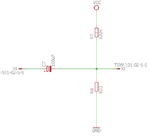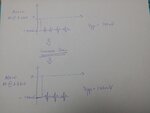Legris
Newbie level 6
I have managed to design a circuit:

that is able to read an ECG signal where the signal is then acquired through a DAQ called TiePie. From there, the signal is then digitally processed (HPF,50Hz removal,etc), through MATLAB. Everything is fine. However the problem now is that when I tried to increase the gain, the Vpp of the waveform (140mV) remains the same but the waveform starts to shift lower towards the negative side. A friend of mine told me to put in an AC coupling DC bias level stage,

I added this right after JP3. It works well and maintain the waveform signal at 0 axis when read on the oscilloscope. However, when I tried to increase the gain of the signal, it only increase by a few mV. Can anyone tell me whats wrong or is the so called AC coupling DC bias level is wrong ? Is there any better alternatives ? Did I design the right AC coupling stage ?

that is able to read an ECG signal where the signal is then acquired through a DAQ called TiePie. From there, the signal is then digitally processed (HPF,50Hz removal,etc), through MATLAB. Everything is fine. However the problem now is that when I tried to increase the gain, the Vpp of the waveform (140mV) remains the same but the waveform starts to shift lower towards the negative side. A friend of mine told me to put in an AC coupling DC bias level stage,

I added this right after JP3. It works well and maintain the waveform signal at 0 axis when read on the oscilloscope. However, when I tried to increase the gain of the signal, it only increase by a few mV. Can anyone tell me whats wrong or is the so called AC coupling DC bias level is wrong ? Is there any better alternatives ? Did I design the right AC coupling stage ?
